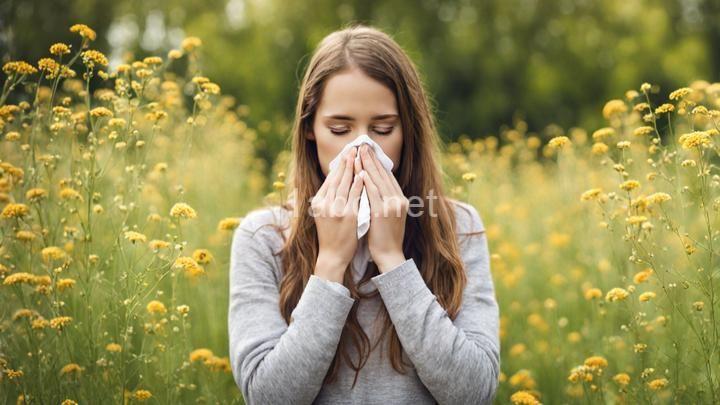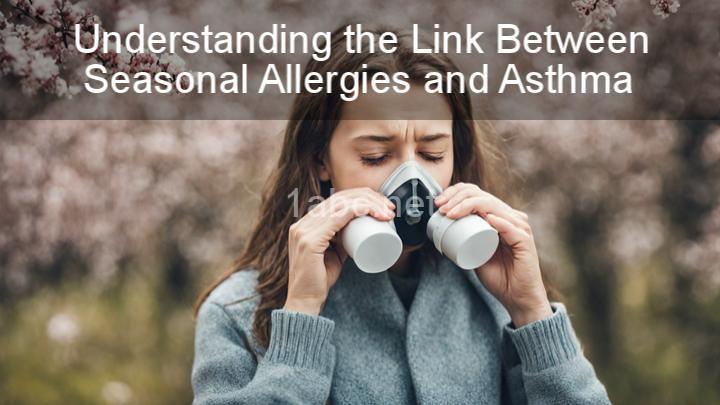Understanding the Basics of Allergies: Causes, Symptoms, and Treatment

IntroductionWelcome readers to this comprehensive blog post on understanding the basics of allergies. Allergies are a common health concern that affects millions of people worldwide. In this blog post, we will explore the causes, symptoms, and treatment options for allergies. It is important to have a good understanding of allergies because it allows us to take necessary precautions and seek appropriate medical help. So let's dive right in!
What are Allergies?
To begin with, let's define what allergies are. Allergies are an overreaction of the immune system to substances that are normally harmless. These substances, known as allergens, can trigger an allergic response in susceptible individuals. When an allergen enters the body, the immune system produces antibodies called immunoglobulin E (IgE) to fight off the perceived threat.
How allergies occur in the body is an interesting process. When a person with allergies comes into contact with an allergen, such as pollen or dust mites, their immune system recognizes it as a foreign invader. In response, the immune system releases chemicals, such as histamine, which cause the characteristic symptoms of allergies.
Common Causes of Allergies
Allergies can be triggered by various factors, and it is essential to understand the common causes. Environmental triggers, such as pollen, pet dander, mold, and dust mites, are some of the most prevalent allergens. These substances are found in our everyday surroundings, and exposure to them can lead to allergic reactions.
Food allergens are another significant cause of allergies. Common allergenic foods include peanuts, tree nuts, milk, eggs, soy, wheat, fish, and shellfish. In some cases, even a small amount of these allergens can cause severe allergic reactions, known as anaphylaxis.
Certain medications can also cause allergic reactions in some individuals. Antibiotics, nonsteroidal anti-inflammatory drugs (NSAIDs), and anticonvulsants are examples of medications that may trigger allergies. It is important to note that not everyone will have an allergic reaction to these substances, but those who do should be cautious.
Recognizing Allergy Symptoms
Identifying the symptoms of allergies is crucial for prompt diagnosis and treatment. Allergy symptoms can vary depending on the type of allergen and the individual's immune response. Common symptoms of allergies include sneezing, itchy or watery eyes, runny nose, nasal congestion, coughing, wheezing, shortness of breath, hives, and skin rashes.
For example, if you are allergic to pollen, you may experience symptoms such as sneezing, itchy eyes, and a runny nose during the spring season when pollen counts are high. On the other hand, if you have a food allergy, you might develop hives or experience digestive issues like nausea and vomiting shortly after consuming the allergenic food.
It is important to differentiate between allergies and other conditions that may have similar symptoms. For instance, a common cold may cause sneezing, congestion, and a runny nose, but these symptoms usually subside within a week. Allergies, on the other hand, tend to persist as long as the person is exposed to the allergen.
Seeking Medical Diagnosis and Testing
If you suspect that you have allergies, it is essential to consult a healthcare professional for an accurate diagnosis. They will take your medical history, ask about your symptoms, and perform a physical examination. Based on your symptoms and medical history, the healthcare professional may recommend specific allergy tests to determine the exact cause of your allergies.
One of the most common allergy tests is a skin prick test, where small amounts of allergens are placed on your skin, and the doctor observes for a reaction. If you are allergic to a particular allergen, you may develop a raised bump or a red, itchy spot at the test site. Blood tests, such as the specific IgE test, can also be used to measure the levels of IgE antibodies in your blood to identify allergens.
Managing Allergy Symptoms at Home
While medical intervention is necessary for severe allergies, there are steps you can take at home to manage mild to moderate allergy symptoms. Reducing exposure to allergens is a key strategy in managing allergies. For instance, if you are allergic to pollen, try to stay indoors during peak pollen times, keep windows closed, and use air purifiers to filter out allergens.
In addition to minimizing exposure, over-the-counter medications can provide relief from allergy symptoms. Antihistamines, such as cetirizine or loratadine, can help alleviate sneezing, itching, and runny nose. Decongestants, available in nasal sprays or oral forms, can relieve nasal congestion. It is important to follow the instructions and consult a healthcare professional if symptoms persist or worsen.
Treatment Options for Severe Allergies
For individuals with severe allergies or those whose symptoms are not adequately controlled with over-the-counter medications, there are additional treatment options available. One such option is allergy shots, also known as immunotherapy. Allergy shots involve injecting small amounts of allergens into the body over time to desensitize the immune system and reduce allergic reactions.
Oral immunotherapy is another treatment option for specific food allergies. In this approach, small amounts of the allergenic food are consumed gradually, under medical supervision, to build tolerance. This can be a life-changing treatment for individuals with severe food allergies, as it allows them to safely consume the allergenic food in small amounts without triggering an allergic reaction.
Living with Allergies
Living with allergies can be challenging, but with the right strategies, it is possible to prevent allergic reactions and create an allergy-friendly environment. Preventing allergic reactions involves being vigilant about avoiding allergens. This may include reading food labels carefully, informing restaurants about your allergies, and carrying emergency medication, such as epinephrine auto-injectors, if necessary.
Creating an allergy-friendly environment at home is equally important. Regular cleaning, using allergen-proof bedding, and maintaining good indoor air quality can help reduce exposure to allergens. If you have pets and are allergic to pet dander, consider keeping them out of your bedroom and regularly grooming them to minimize allergen exposure.
Conclusion
In conclusion, understanding the basics of allergies is essential for managing and living with this common health condition. Allergies can be caused by various environmental triggers, food allergens, and medications. Recognizing the symptoms of allergies and seeking medical help is crucial for accurate diagnosis and appropriate treatment.
Managing allergy symptoms at home involves reducing exposure to allergens and using over-the-counter medications. For individuals with severe allergies, treatment options such as allergy shots and oral immunotherapy can provide long-term relief. By taking necessary precautions and creating an allergy-friendly environment, individuals with allergies can lead fulfilling lives despite their condition.
Remember, if you suspect that you have allergies, it is important to consult a healthcare professional for proper diagnosis and guidance. With the right knowledge and support, you can effectively manage your allergies and enjoy a healthy and happy life.
FREQUENTLY ASKED QUESTIONS
What are allergies?
Allergies are an abnormal immune response to substances that are typically harmless. These substances, known as allergens, can trigger an allergic reaction when they come into contact with the body. Common allergens include pollen, dust mites, pet dander, certain foods, insect venom, and certain medications. Allergic reactions can vary in severity, ranging from mild symptoms like sneezing, itching, or a rash to more severe reactions like difficulty breathing or anaphylaxis, which is a life-threatening emergency. Allergies can develop at any age and may be hereditary.
What are the common causes of allergies?
Common causes of allergies can vary depending on the individual and the specific allergen involved. However, some common triggers for allergic reactions include:
- Pollen: Airborne pollens from trees, grasses, and weeds can cause seasonal allergies (hay fever) in susceptible individuals.
- Dust mites: Microscopic bugs that live in house dust, bedding, and upholstery can trigger allergies.
- Pet dander: Allergies can be triggered by proteins in the skin cells, urine, or saliva of pets like cats and dogs.
- Mold spores: Indoor and outdoor mold growth can release spores that cause allergic reactions.
- Insect stings: Bee stings, wasp stings, and fire ant bites can lead to severe allergic reactions in some people.
- Certain foods: Common food allergens include peanuts, tree nuts, eggs, milk, shellfish, soy, and wheat.
- Medications: Some people can be allergic to certain medications, such as antibiotics (e.g. penicillin), painkillers (e.g. aspirin), or certain types of vaccines.
- Latex: Certain individuals may develop allergies to latex, which is commonly found in gloves, condoms, and other products.
It is important to note that allergic reactions can vary in severity, ranging from mild symptoms like sneezing and itching to more severe reactions that require immediate medical attention.
What are the different types of allergies?
There are several different types of allergies. Some common types include:
- Food allergies: These are allergies to certain types of food, such as nuts, dairy products, eggs, or seafood.
- Environmental allergies: These allergies are caused by substances in the environment, such as pollen, dust mites, mold, or pet dander.
- Drug allergies: Certain medications can cause allergic reactions in some individuals. Common culprits include antibiotics or medications containing aspirin.
- Insect sting allergies: Some people may experience allergic reactions to bee stings, wasp stings, or other insect bites.
- Latex allergies: Latex, a type of rubber material used in gloves, balloons, and other products, can cause allergic reactions in some individuals.
- Allergic skin conditions: Certain skin conditions, like eczema or hives, can be caused by allergic reactions.
It's important to note that allergies can range from mild to severe, and some allergies can be life-threatening. If you suspect you have an allergy, it's best to consult with a healthcare professional for proper diagnosis and management.
What are the symptoms of allergies?
The symptoms of allergies can vary depending on the type and severity of the allergy, but some common symptoms include:
- Sneezing and runny nose
- Itchy, watery eyes
- Itchy throat or ears
- Coughing or wheezing
- Nasal congestion or stuffiness
- Skin rash or hives
- Swelling of the face, lips, tongue, or throat
- Difficulty breathing or shortness of breath
- Headache
- Fatigue or feeling tired
If you are experiencing any of these symptoms, it is recommended to consult with a healthcare professional for a proper diagnosis and management plan.




